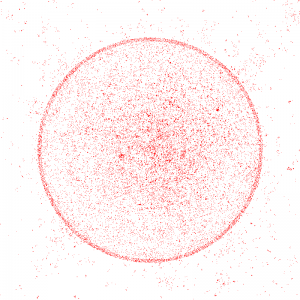Python 3 + PyGame, SQLite, and Travian: Generating the World Map
Background
In the last post I showed you how you could get the Travian game data, load it into SQLite, and then run some simple queries. Now, I will show you how to take that one step further and use the data to generate a BMP, TGA, PNG, or JPEG image!
First, we need to get Pygame. Pygame is actually a Python Game Development library, but we’re just going to be using it for generating images. It’s a small download, and easy install, just make sure you get the right version for your version of Python. There is a library out there called the Python Imaging Library (PIL), but apparently they haven’t updated their code to be compatible with Python 3. Hopefully they do soon!
Now that we have PyGame, we start with the old script we had and add a new function for creating the PNG. I’m saving the image as a PNG, but according to the PyGame documentation, you should be able to output your image as BMP, TGA, PNG, or JPEG, simply based on what your file’s extension is.

The New Code
The function below is the new function that does the work. It:
- Creates an image surface to work with. (based on the map size)
- Reads the data back from SQLite.
- Sets each pixel that has a village to the color red.
-
Saves the image to disk.
def create_map(database_name): sql_connection = sqlite3.connect(database_name) sql_cursor = sql_connection.cursor()
#Min/Max query for calculating how big the map is sql_mins_maxes = """SELECT MIN(X), MIN(y), MAX(x), MAX(y) FROM x_world""" sql_cursor.execute(sql_mins_maxes) row = sql_cursor.fetchone() min_x = row[0] min_y = row[1] max_x = row[2] max_y = row[3] width = max_x - min_x height = max_y - min_y x_offset = width // 2 y_offset = height // 2 # Locations query sql_all = """SELECT x, y FROM x_world""" #Current working directory current_directory = os.getcwd() #Create a surface (like an image canvas) surface = pygame.Surface((width, height)) #Paint the background white back_color = pygame.Color(255, 255, 255, 255) surface.fill(back_color) #The color red for coloring the villages color = pygame.Color(255, 0, 0, 255) sql_cursor.execute(sql_all) #For each village, set the corresponding pixel to red for row in sql_cursor.fetchall(): surface.set_at((row[0] + x_offset,row[1] + y_offset), color) #Save the image to disk #Will save as a PNG file because of the extension pygame.image.save(surface, os.path.join(current_directory, "test.png")) sql_connection.commit() sql_connection.close()
The Full Code
And here is the complete updated code that runs great with my installation of Python 3.12 and PyGame 1.91. I hope you boys and girls enjoyed the update!
#!/usr/bin/env python
import os # For working with the file system
import urllib.request # For getting data from web pages
import sqlite3 # for data persistence
import pygame.surface
import pygame.image
def main():
script_url = "http://s1.travian.com/map.sql"
data_file_name = "map.sql"
database_name = "travian"
print("Downloading data file \nfrom:\t{0}\nto:\t{1}\n...".format(script_url , data_file_name))
download(script_url, data_file_name);
print("Done.\n")
print("Creating table if needed...")
create_table(database_name)
print("Done.\n")
print("Clearing old data if needed...")
clear_data(database_name)
print("Done.\n")
print("Loading data file into SQL Lite...")
load_data(database_name, data_file_name)
print("Done.\n")
print("Statistics:")
print_stats(database_name)
print("\n")
print("Generating world map...")
create_map(database_name)
print("Done.\n")
# Originally from http://code.activestate.com/recipes/496685-downloading-a-file-from-the-web/
# Copy the contents of a file from a given URL to a local file.
def download(url, file_name):
urllib.request.urlretrieve(url, file_name)
def create_table(database_name):
#Try and create the table.
#If it fails, it's probably because the table exists
try:
table_sql = """CREATE TABLE `x_world` (
id integer PRIMARY KEY ASC AUTOINCREMENT NOT NULL DEFAULT '0',
x integer NOT NULL default '0',
y integer NOT NULL default '0',
tid integer unsigned NOT NULL default '0',
vid integer unsigned NOT NULL default '0',
village text NOT NULL default '',
uid integer NOT NULL default '0',
player text NOT NULL default '',
aid integer unsigned NOT NULL default '0',
alliance text NOT NULL default '',
population integer unsigned NOT NULL default '0'
);"""
#Open a connection to the SQLite database and create the table
sql_connection = sqlite3.connect(database_name)
sql_cursor = sql_connection.cursor()
sql_cursor.execute(table_sql)
sql_connection.commit()
sql_connection.close()
except:
pass
def clear_data(database_name):
sql_connection = sqlite3.connect(database_name)
sql_cursor = sql_connection.cursor()
sql_command = "DELETE FROM x_world"
#Delete all the existing data, if there is any
sql_cursor.execute(sql_command)
sql_connection.commit()
sql_connection.close()
def load_data(database_name, data_file_name):
#Open the data file
data_file = open(data_file_name, mode='r', encoding="UTF8")
sql_connection = sqlite3.connect(database_name)
sql_cursor = sql_connection.cursor()
#Run each SQL statement from the data file
for line in data_file:
sql_cursor.execute(line)
sql_connection.commit()
sql_connection.close()
def print_stats(database_name):
sql_connection = sqlite3.connect(database_name)
sql_cursor = sql_connection.cursor()
#Population query
sql_population = """SELECT SUM(population)
FROM x_world"""
sql_cursor.execute(sql_population)
population = sql_cursor.fetchone()[0]
#User count query
sql_count_users = """SELECT COUNT(DISTINCT(uid))
FROM x_world"""
sql_cursor.execute(sql_count_users)
user_count = sql_cursor.fetchone()[0]
#Village count query
sql_count_villages = """SELECT COUNT(*)
FROM x_world"""
sql_cursor.execute(sql_count_villages)
village_count = sql_cursor.fetchone()[0]
#Print results
print("Population of Travian: {0}".format(population))
print("Number of users in Travian: {0}".format(user_count))
print("Number of villages in Travian: {0}".format(village_count))
sql_connection.commit()
sql_connection.close()
def create_map(database_name):
sql_connection = sqlite3.connect(database_name)
sql_cursor = sql_connection.cursor()
#Min/Max query for calculating how big the map is
sql_mins_maxes = """SELECT MIN(X), MIN(y), MAX(x), MAX(y)
FROM x_world"""
sql_cursor.execute(sql_mins_maxes)
row = sql_cursor.fetchone()
min_x = row[0]
min_y = row[1]
max_x = row[2]
max_y = row[3]
width = max_x - min_x
height = max_y - min_y
x_offset = width // 2
y_offset = height // 2
# Locations query
sql_all = """SELECT x, y
FROM x_world"""
#Current working directory
current_directory = os.getcwd()
#Create a surface (like an image canvas)
surface = pygame.Surface((width, height))
#Paint the background white
back_color = pygame.Color(255, 255, 255, 255)
surface.fill(back_color)
#The color red for coloring the villages
color = pygame.Color(255, 0, 0, 255)
sql_cursor.execute(sql_all)
#For each village, set the corresponding pixel to red
for row in sql_cursor.fetchall():
surface.set_at((row[0] + x_offset,row[1] + y_offset), color)
#Save the image to disk
#Will save as a PNG file because of the extension
pygame.image.save(surface, os.path.join(current_directory, "test.png"))
sql_connection.commit()
sql_connection.close()
#Run the main function
main()